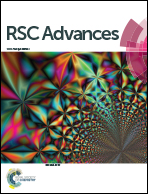Synthesis and characterization of trinuclear N-heterocyclic carbene–palladium(ii) complexes and their applications in the Suzuki–Miyaura cross-coupling reaction†
Abstract
Five novel trinuclear N-heterocyclic carbene–palladium(II) complexes 5a–e were conveniently synthesized through one-pot reactions of imidazolium salts, tridentate N-heterocycles {tris(4-(pyridin-4-yl)phenyl)amine or tris(4-(pyridin-3-yl)phenyl)amine} and palladium chloride in one step. All of the new complexes have been fully characterized by elemental analysis, 1H, 13C NMR, and IR spectra. Among them, the molecular structures of complex 5d have been determined by X-ray single-crystal diffraction. Moreover, the obtained trinuclear palladium(II) complexes were the effective catalyst precursors for the Suzuki–Miyaura coupling of aryl as well as benzyl chlorides with arylboronic acids. Under the optimal reaction conditions, the expected biaryl products were obtained in good to almost quantitative yields.


 Please wait while we load your content...
Please wait while we load your content...